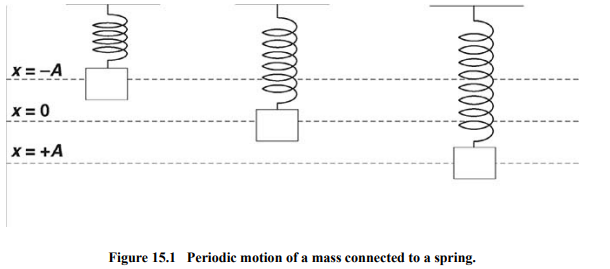
Simple Harmonic Motion
Key Ideas
There are three conditions for something to be in simple harmonic motion. All are equivalent.
The object’s position–time graph is a sine or cosine graph.
The restoring force on the object is proportional to its displacement from equilibrium.
The energy vs. position graph is parabolic.
The mass on a spring is the most common example of simple harmonic motion.
The pendulum is in simple harmonic motion for small amplitudes.
Amplitude, Period, and Frequency
Simple harmonic motion is the study of oscillations.
An oscillation is the motion of an object that regularly repeats itself over the same path.
Objects undergo oscillation when they experience a restoring force: a force that restores an object to the equilibrium position.
A restoring force doesn’t need to bring an object to rest in its equilibrium position; it just needs to make that object pass through an equilibrium position.
The time it takes for an object to pass through one cycle is the period, abbreviated T.

Vibrating Mass on a Spring
A mass attached to the end of a spring will oscillate in simple harmonic motion. The period of the oscillation is found by this equation:

m is the mass of the object on the spring
k is the “spring constant.”
To find the period, all we need to know is the mass.
When dealing with a vertical spring, it is best to define the rest position as x = 0 in the equation for the potential energy of the spring.
If we do this, then gravitational potential energy can be ignored.
Pendulums
Simple Pendulums
the formula for the period of a simple pendulum is:

L is the length of the pendulum
g is the acceleration attributable to gravity
the period of a pendulum does not depend on the mass of whatever is hanging on the end of the pendulum.
To calculate the period of a pendulum, we must know the length of the string.
Compound Pendulum
If the hanging mass has a size approaching the length of the string, the period of this “compound” pendulum is

I is the rotational inertia of the hanging mass
m is the hanging mass
d is the distance from the center of mass to the top of the string.
Simple Harmonic Motion
Key Ideas
There are three conditions for something to be in simple harmonic motion. All are equivalent.
The object’s position–time graph is a sine or cosine graph.
The restoring force on the object is proportional to its displacement from equilibrium.
The energy vs. position graph is parabolic.
The mass on a spring is the most common example of simple harmonic motion.
The pendulum is in simple harmonic motion for small amplitudes.
Amplitude, Period, and Frequency
Simple harmonic motion is the study of oscillations.
An oscillation is the motion of an object that regularly repeats itself over the same path.
Objects undergo oscillation when they experience a restoring force: a force that restores an object to the equilibrium position.
A restoring force doesn’t need to bring an object to rest in its equilibrium position; it just needs to make that object pass through an equilibrium position.
The time it takes for an object to pass through one cycle is the period, abbreviated T.

Vibrating Mass on a Spring
A mass attached to the end of a spring will oscillate in simple harmonic motion. The period of the oscillation is found by this equation:

m is the mass of the object on the spring
k is the “spring constant.”
To find the period, all we need to know is the mass.
When dealing with a vertical spring, it is best to define the rest position as x = 0 in the equation for the potential energy of the spring.
If we do this, then gravitational potential energy can be ignored.
Pendulums
Simple Pendulums
the formula for the period of a simple pendulum is:

L is the length of the pendulum
g is the acceleration attributable to gravity
the period of a pendulum does not depend on the mass of whatever is hanging on the end of the pendulum.
To calculate the period of a pendulum, we must know the length of the string.
Compound Pendulum
If the hanging mass has a size approaching the length of the string, the period of this “compound” pendulum is

I is the rotational inertia of the hanging mass
m is the hanging mass
d is the distance from the center of mass to the top of the string.
 Knowt
Knowt
